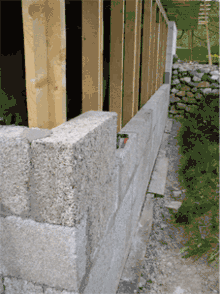Hempcrete
Hempcrete or hemplime is biocomposite material, a mixture of hemp hurds (shives) and lime,[1] sand, or pozzolans, which is used as a material for construction and insulation.[2] It is marketed under names like Hempcrete, Canobiote, Canosmose, and Isochanvre.[3] Hempcrete is easier to work with than traditional lime mixes and acts as an insulator and moisture regulator. It lacks the brittleness of concrete and consequently does not need expansion joints.[3] The result is a lightweight insulating material ideal for most climates as it combines insulation and thermal mass.

Applications and specifications
Hempcrete has been used in France since the early 1990s to construct non-weight bearing insulating infill walls, as hempcrete does not have the requisite strength for constructing foundation and is instead supported by the frame.[4] Hempcrete was also used to renovate old buildings made of stone or lime.[5] France continues to be an avid user of hempcrete, and it grows in popularity there annually.[6]
The typical compressive strength is around 1 MPa,[7] around 5% that of residential grade concrete. It is a low density material and resistant to cracking under movement, thus making it suitable for use in earthquake-prone areas.[8] Hempcrete walls must be used together with a frame of another material that supports the vertical load in building construction, as hempcrete's density is 15% that of traditional concrete.[9] Studies in the UK indicate that the performance gain between 9” (22cm) and 12”( 30cm) walls is insignificant. Hempcrete walls are fireproof, transmit humidity, resist mould, and have excellent acoustic performance.[10] Limecrete, Ltd. (UK) reports a fire resistance rating of 1 hour per British/EU standards.[11]
In the United States, a permit is needed for the use of hemp in building.[12]
Hempcrete's R-Value (its resistance to heat transfer) is 2.4/inch, making it an efficient insulating material (the higher the R-Value, the better the insulation). [13]
See also
References
- Allin, Steve. Building with Hemp, Seed Press, 2005, ISBN 978-0-9551109-0-0. (p. 146, 1st Edition).
- "NNFCC Renewable Building Materials Factsheet: An Introduction". National Non-Food Crops Centre. February 21, 2008. Retrieved 2011-02-16.
- Priesnitz, Rolf B. (March–April 2006). "Hemp For Houses". Natural Life Magazine.
- "6 Advantages of Building With Hempcrete". Green Building Canada. 2017-06-29. Retrieved 2019-08-10.
- Jeremy Hodges and Kevin Orland (2019-08-30). "Builders Are Swapping Cement for Weed to Reduce Pollution".
- Rhydwen, Ranyl (2018-05-18). "Building with Hemp and Lime". Cite journal requires
|journal=(help) - "Tradical Hemcrete 2008 Information Pack". American Lime Technology. Retrieved 2010-05-15.
- "Hempcrete properties". www.minoeco.com.
- Flahiff, Daniel (August 24, 2009). "Hemcrete®: Carbon Negative Hemp Walls". Inhabitat.
- "Hempcrete". Carbon Smart Materials Palette, a project of Architecture 2030. Retrieved 2019-08-10.
- Abbott, Tom (2014-04-26). "Hempcrete Factsheet". The Limecrete Company, Ltd.
- Popescu, Adam (2018). "There's No Place Like Home, Especially if It's Made of Hemp". The New York Times. Retrieved 4 May 2018.
- "Hempcrete Insulation". Hempcrete Direct. 2019-11-21. Retrieved 2020-05-20.
Further reading
- Magwood, Chris (2016-06-17). Essential hempcrete contruction : the complete step-by-step guide. Gabriola Island, BC, Canada. ISBN 9781550926132. OCLC 947134507.
External links
| Wikimedia Commons has media related to Hemp concrete. |
- Hemcrete application data from Limetechnology